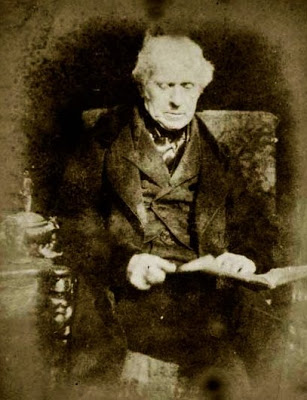Philosophy
 Sir David Brewster
Sir David Brewster
December 11th, 1781 to 10 February 10th, 1868
Calotype taken by Hill & Adamson between 1843 and 1847

Probably best known for the invention of the stereoscope and kaleidoscope...from "...the Greek words, kalos or beautiful, eidos or form, and scopos or watcher. So kaleidoscope means the beautiful form watcher."
University of St. Andrews:
David Brewster is chiefly remembered today for his invention of the kaleidoscope. However his interests lay in a wide variety of areas, and he started early, constructing a telescope, for example, by the age of ten. Concerned with the behaviour and make up of light, he was deeply involved in the early days of photography. In his wide cricle of illustrious friends he could count the likes of the writer Sir Walter Scott (1771-1832) and many painters, such as Alexander Nasmyth (1758-1840) and JMW Turner (1775-1851) He was a considerable writer himself, editing many scientific journals, and a biography of Sir Isaac Newton is among his numerous publications. Few are aware that he was also a licensed Church of Scotland Minister, although he abandoned a career in the ministry. It may also come as a surprise that the Principal of the United Colleges of St Salvator and St Leonard in the University of St Andrews was terrified of speaking in public.
Brewster's main experiments were on the theory of light and its uses and Some Properties of Light, his first paper, was published in 1813. `Brewster's Rule' was named after his 1814 researches into polarisation using biaxial crystals. He often adapted and improved existing technical instruments to suit his researches, as well as developing new tools. His studies led to the discovery of the principle behind the kaleidoscope in 1816. His invention was faultily patented on 30th August 1817, and he published his Treatise on the Kaleidoscope in 1819. Although intended as a scientific tool, the discovery was sold very quickly as a toy for the amusement of adults and children . It was extremely popular and soon became something of a craze, like the fad for Rubik's Cube in the 1980s. It is hoped that the giant kaleidoscope in the second room of this exhibition will proove to be as popular!
Another of Brewster's instruments quickly became a favourite toy. The Lenticular Stereoscope was used to produce a 3-D image, and came as a result of his involvement in early photography. When examples were sent to the 1851 Great Exhibition at Crystal Palace, Queen Victoria was apparently fascinated by it, starting off another craze.
Reports on Brewster's character vary. He was apparently liked by his young students at St Andrews (average age 12-13), however, it is also said that, "Nobody ever had dealings with him and escaped a quarrel," and in 1859 he left St Andrews to become Principal of Edinburgh University. He has the distinction of being awarded all three principal medals of the Roual Society for his optical researches: the Copley, Rumford and Royal medals, which he gained in 1815, 1818 and 1830 respectively. Brewster was certainly one of the most energetic scholars of his period, interested in a great variety of areas, and he has left behind an intriguing set of scientific instruments.
A Treatise on Optics
Lives of the Most Eminent Literary and Scientific Men of Italy, Spain and Portugal Vol. 1
Lives of the Most Eminent Literary and Scientific Men of Italy, Spain and Portugal Vol. 2
Lives of the Most Eminent Literary and Scientific Men of Italy, Spain and Portugal Vol. 3
Memoirs of the life writings, and discoveries of Sir Isaac Newton
The Martyrs of Science or The Lives of Galileo, Tycho Brahe, and Kepler
- Dover Publications' Popular Reprints Of Science Books
Back in print from Dover Publications. A History of Astronomy by A. Pannekoek Well-balanced, carefully reasoned study covers such topics as Ptolemaic theory, work of Copernicus, Kepler, Newton, Eddington's work on stars, much more. Illustrated....
- Nicéphore Niépce And The First Photograph
Nicéphore Niépce March 7th, 1765 to July 5th, 1833 This is the first known photograph. Digital photographers could care less, but Nicéphore Niépce is a significant pioneer in the development of photography who provided the first photographic image...
- "isaac Newton And Physics For Kids"--book Review
"Isaac Newton and Physics for Kids" by Kathy Ceceri June 26th, 2010 Wired A lot of nonfiction for kids in upper elementary and middle school is what I think of as “book report books.” They’re packed with facts, but not presented in a way that...
- Paolo Frisi...hydraulics, Lightning, Public Relations
Paolo Frisi April 13th, 1728 – November 22nd, 1784 If you want a good public relations person [popularized Galileo Galilei and Sir Isaac Newton] and an expert on the physics of hydraulics...and, the inventor of the lightning rod, then Paolo Frisi was...
- Science Toys
Never too old to have some fun with science toys. "Science toys" Tim Rowett is an avid collector of science-related toys. Robert P Crease and son drop in to play with them. by Robert P Crease January 5th, 2009 physicsworld.com "I have a low boredom...
Philosophy
Sir David Brewster...optics--the kaleidoscope
 Sir David Brewster
Sir David BrewsterDecember 11th, 1781 to 10 February 10th, 1868
Calotype taken by Hill & Adamson between 1843 and 1847

University of St. Andrews:
David Brewster is chiefly remembered today for his invention of the kaleidoscope. However his interests lay in a wide variety of areas, and he started early, constructing a telescope, for example, by the age of ten. Concerned with the behaviour and make up of light, he was deeply involved in the early days of photography. In his wide cricle of illustrious friends he could count the likes of the writer Sir Walter Scott (1771-1832) and many painters, such as Alexander Nasmyth (1758-1840) and JMW Turner (1775-1851) He was a considerable writer himself, editing many scientific journals, and a biography of Sir Isaac Newton is among his numerous publications. Few are aware that he was also a licensed Church of Scotland Minister, although he abandoned a career in the ministry. It may also come as a surprise that the Principal of the United Colleges of St Salvator and St Leonard in the University of St Andrews was terrified of speaking in public.
Brewster's main experiments were on the theory of light and its uses and Some Properties of Light, his first paper, was published in 1813. `Brewster's Rule' was named after his 1814 researches into polarisation using biaxial crystals. He often adapted and improved existing technical instruments to suit his researches, as well as developing new tools. His studies led to the discovery of the principle behind the kaleidoscope in 1816. His invention was faultily patented on 30th August 1817, and he published his Treatise on the Kaleidoscope in 1819. Although intended as a scientific tool, the discovery was sold very quickly as a toy for the amusement of adults and children . It was extremely popular and soon became something of a craze, like the fad for Rubik's Cube in the 1980s. It is hoped that the giant kaleidoscope in the second room of this exhibition will proove to be as popular!
Another of Brewster's instruments quickly became a favourite toy. The Lenticular Stereoscope was used to produce a 3-D image, and came as a result of his involvement in early photography. When examples were sent to the 1851 Great Exhibition at Crystal Palace, Queen Victoria was apparently fascinated by it, starting off another craze.
Reports on Brewster's character vary. He was apparently liked by his young students at St Andrews (average age 12-13), however, it is also said that, "Nobody ever had dealings with him and escaped a quarrel," and in 1859 he left St Andrews to become Principal of Edinburgh University. He has the distinction of being awarded all three principal medals of the Roual Society for his optical researches: the Copley, Rumford and Royal medals, which he gained in 1815, 1818 and 1830 respectively. Brewster was certainly one of the most energetic scholars of his period, interested in a great variety of areas, and he has left behind an intriguing set of scientific instruments.
A Treatise on Optics
Lives of the Most Eminent Literary and Scientific Men of Italy, Spain and Portugal Vol. 1
Lives of the Most Eminent Literary and Scientific Men of Italy, Spain and Portugal Vol. 2
Lives of the Most Eminent Literary and Scientific Men of Italy, Spain and Portugal Vol. 3
Memoirs of the life writings, and discoveries of Sir Isaac Newton
The Martyrs of Science or The Lives of Galileo, Tycho Brahe, and Kepler
- Dover Publications' Popular Reprints Of Science Books
Back in print from Dover Publications. A History of Astronomy by A. Pannekoek Well-balanced, carefully reasoned study covers such topics as Ptolemaic theory, work of Copernicus, Kepler, Newton, Eddington's work on stars, much more. Illustrated....
- Nicéphore Niépce And The First Photograph
Nicéphore Niépce March 7th, 1765 to July 5th, 1833 This is the first known photograph. Digital photographers could care less, but Nicéphore Niépce is a significant pioneer in the development of photography who provided the first photographic image...
- "isaac Newton And Physics For Kids"--book Review
"Isaac Newton and Physics for Kids" by Kathy Ceceri June 26th, 2010 Wired A lot of nonfiction for kids in upper elementary and middle school is what I think of as “book report books.” They’re packed with facts, but not presented in a way that...
- Paolo Frisi...hydraulics, Lightning, Public Relations
Paolo Frisi April 13th, 1728 – November 22nd, 1784 If you want a good public relations person [popularized Galileo Galilei and Sir Isaac Newton] and an expert on the physics of hydraulics...and, the inventor of the lightning rod, then Paolo Frisi was...
- Science Toys
Never too old to have some fun with science toys. "Science toys" Tim Rowett is an avid collector of science-related toys. Robert P Crease and son drop in to play with them. by Robert P Crease January 5th, 2009 physicsworld.com "I have a low boredom...
